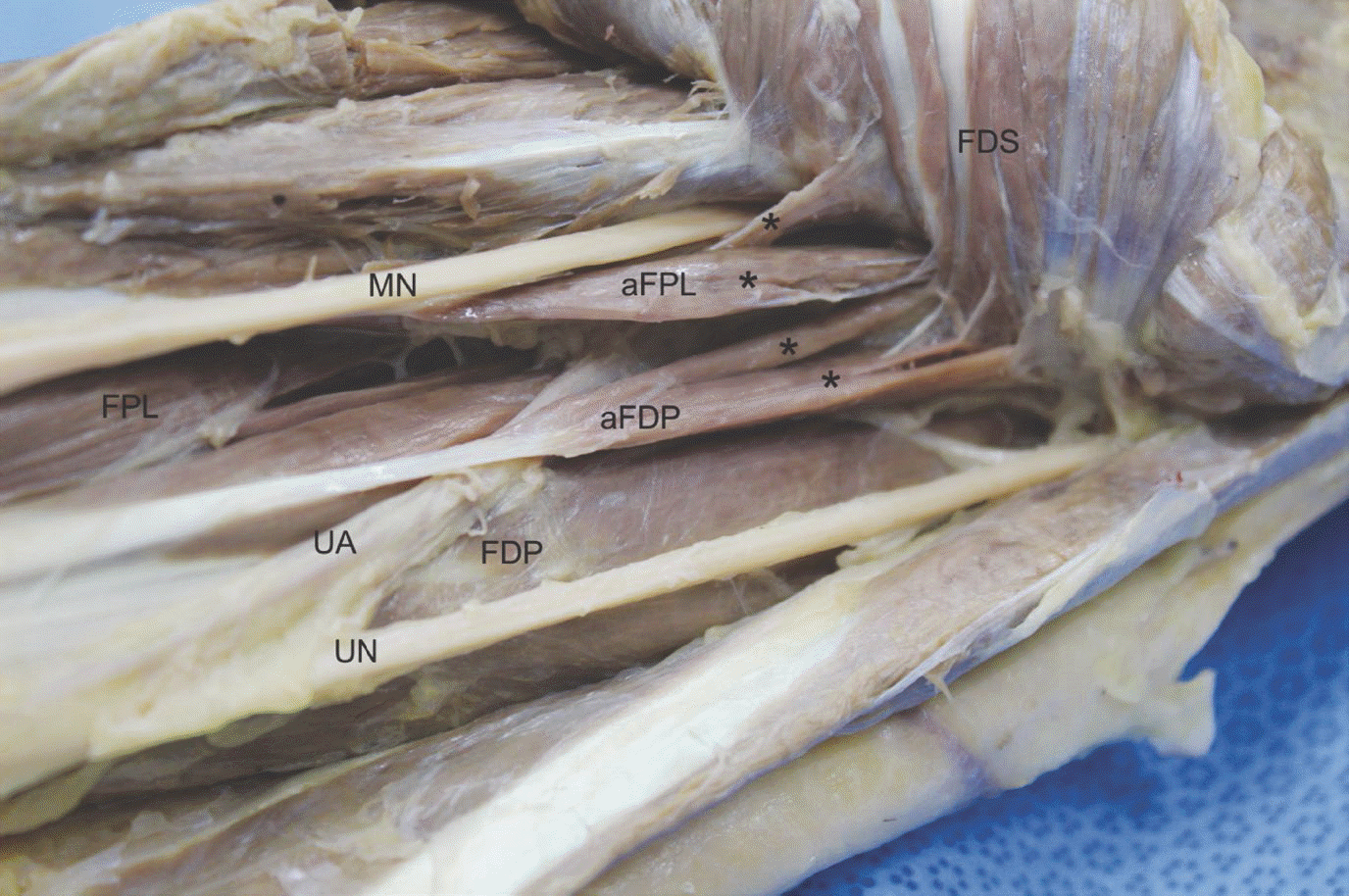Abstract
The Gantzer's muscle (GM) is an additional muscle in the forearm as the accessory head of the flexor pollicis longus (FPL) and accessory head of the flexor digitorum profundus (FDP). We reported a rare case of double GM formed by four muscle bellies. From the dorsal part of flexor digitorum superficialis, small four bellies formed two muscles merging to FDP and FPL, as GMs. These accessory heads of FDP and FPL crossed the ulnar artery and the median nerve, respectively. These additional muscles in the forearm flexor compartment are rare and its clinical and embryological significances should be considered.
Go to : 
References
1. Al-Qattan M. Gantzer's muscle: An anatomical study of the accessory head of the flexor pollicis longus muscle. J Hand Surg Br. 1996; 21:269–70.
2. El Domiaty MA, Zoair MM, Sheta AA. The prevalence of accessory heads of the flexor pollicis longus and the flexor digitorum profundus muscles in Egyptians and their relations to median and anterior interosseous nerves. Folia Morphol. 2008; 67:63–71.
3. Kara A, Elvan O, Yildiz S, Ozturk H. Accessory head of flexor pollicis longus muscle in fetuses and adult cadavers and its relation to anterior interosseous nerve. Clin Anat. 2012; 25:601–8.

4. Oh CS, Chung IH, Koh KS. Anatomical study of the accessory head of the flexor pollicis longus and the anterior interosseous nerve in Asians. Clin Anat. 2000; 13:434–8.

5. Shirali S, Hanson M, Branovacki G, Gonzalez M. The flexor pollicis longus and its relation to the anterior and posterior interosseous nerves. J Hand Surg Br. 1998; 23:170–2.

6. Tabib W, Aboufarah F, Asselineau A. Compression of the anterior interosseous nerve by Gantzer's muscle. Chir Main. 2001; 20:241–6.
7. Riveros A, Olave E, Sousa-Rodrigues C. Anatomical study of the accessory head of the flexor pollicis longus and its relation to the anterior interosseous nerve in Brazilian individuals. Int J Morphol. 2015; 33:31–5.
8. Roy J, Henry BM, Pękala PA, Vikse J, Ramakrishnan PK, Walocha JA, et al. The prevalence and anatomical characteristics of the accessory head of the flexor pollicis longus muscle: a metaanalysis. PeerJ. 2015; 3:e1255.

9. Pai MM, Nayak SR, Krishnamurthy A, Vadgaonkar R, Prabhu LV, Ranade AV, et al. The accessory heads of flexor pollicis longus and flexor digitorum profundus: Incidence and morphology. Clin Anat. 2008; 21:252–8.

10. Jones M, Abrahams PH, Sanudo JR, Campillo M. Inci-dence and morphology of accessory heads of flexor pollicis longus and flexor digitorum profundus (Gantzer's muscles). J Anat. 1997; 191:451–5.

11. Nayak SR, Sharma S, Dasgupta H, Bhattacharya K. Presence of triple Gantzer's muscle – a rare anatomical variation. NUJHS. 2013; 3:69–71.

12. Eid N, Otsuki Y. A case of double Gantzer's muscle and its possible role in nerve entrapment. Clin Anat. 2009; 22:881–2.

13. Yang K, Jung SJ, Lee H, Choi IJ, Lee JH. Topographical relations between the Gantzer's muscle and neurovascular structures. Surg Radiol Anat. 2017.DOI:10.1007/s00276-016-1803-x.
Go to : 
 | Fig. 1.Under flexor digitorum superficialis (FDS), four muscle bellies (∗) formed two Gantzer's muscles, as accessory heads of the flexor digitorum profundus (aFDP) and flexor pollcis longus (aFPL). FDP, flexor digitorum profundus; FPL, flexor pollcis longus; MN, median nerve; UA, ulnar artery; UN, ulnar nerve. |




 PDF
PDF ePub
ePub Citation
Citation Print
Print


 XML Download
XML Download